
Ho Chi Minh City, formerly and still commonly known as Saigon, is the most populous city in Vietnam, with a population of around 9 million in 2019. Situated in the Southeast region of Vietnam, the city surrounds the Saigon River and covers about 2,061 km2 (796 sq mi).

The Fall of Saigon, also known as the Liberation of Saigon or Liberation of the South by the Vietnamese government, and known as Black April by anti-communist overseas Vietnamese, was the capture of Saigon, the capital of South Vietnam, by the People's Army of Vietnam (PAVN) and the National Liberation Front of South Vietnam on 30 April 1975. The event marked the end of the Vietnam War and the collapse of the non-communist South Vietnamese regime as well as the start of a transition period from the formal reunification of Vietnam into the Socialist Republic of Vietnam under communist rule.

Nguyễn Xuân Oánh, nicknamed Jack Owens, was a Vietnamese economist and politician who held senior positions in the governments of both South Vietnam and the current Socialist Republic of Vietnam.

Relations between the United States and Vietnam have historically been complex and have repeatedly switched back and forth between positive and negative, but the United States and Vietnam share warm diplomatic relations in the present.
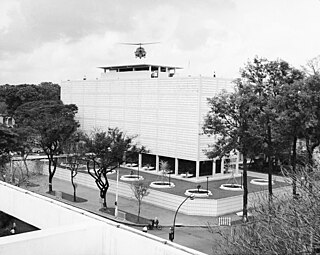
The United States Embassy in Saigon was first established in June 1952, and moved into a new building in 1967 and eventually closed in 1975. The embassy was the scene of a number of significant events of the Vietnam War, most notably the Viet Cong attack during the Tet Offensive which helped turn American public opinion against the war, and the helicopter evacuation during the Fall of Saigon after which the embassy closed permanently.
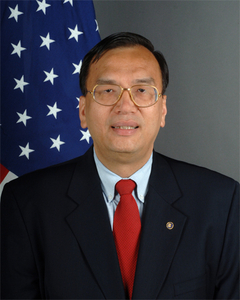
An Thanh Le,, born 1954, previously served as the Consul General for the US in Ho Chi Minh City, Vietnam, followed by Rena Bitter.

Indonesia and Vietnam established diplomatic relations in 1955. Indonesia has an embassy in Hanoi. Vietnam has an embassy in Jakarta. Both are neighboring nations that have a maritime border which lies on the South China Sea and are members of ASEAN and APEC.
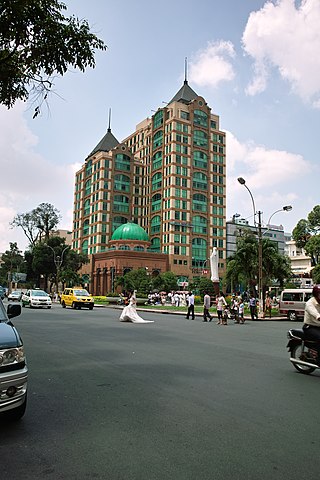
The Consulate General of Canada in Ho Chi Minh City is located on the 10th Floor of Ho Chi Minh City's Metropolitan Building at 235 Đồng Khởi Street, in District 1.

1947–1950 in French Indochina focuses on events influencing the eventual decision for military intervention by the United States in the First Indochina War. In 1947, France still ruled Indochina as a colonial power, conceding little real political power to Vietnamese nationalists. French Indochina was divided into five protectorates: Cambodia, Laos, Tonkin, Annam, and Cochinchina. The latter three made up Vietnam.
The Taipei Economic and Cultural Office, Ho Chi Minh City represents the interests of Taiwan in the southern regions of Vietnam and Cambodia, functioning as a de facto consulate in the absence of diplomatic relations. There is also a Taipei Economic and Cultural Office in Vietnam located in Hanoi, which has responsibility for relations with the northern regions of Vietnam as well as Laos.
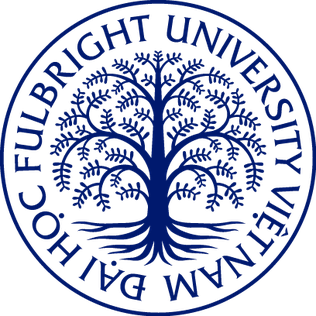
Fulbright University Vietnam (FUV) is a private nonprofit university currently located at the Crescent Plaza in Phú Mỹ Hưng in Hồ Chí Minh City, Vietnam. It is one of Vietnam's first private, nonprofit institutions of higher education. The FUV concept emerged from discussions convened by the Vietnam Program at the Harvard Kennedy School aimed at planning the next stage in the development of the Fulbright Economics Teaching Program (FETP), a center of public policy research and teaching in Hồ Chí Minh City.
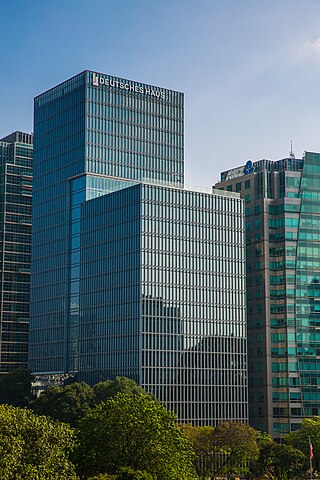
The Deutsches Haus Ho Chi Minh City is a building complex in Ho Chi Minh City, Vietnam, which was opened 2017. The 25-story building complex was initiated under a bilateral government agreement between Germany and Vietnam, with the purpose of setting standards for energy efficiency “made in Germany.” It is the location of the German Consulate General and other institutions and businesses, as well as a cultural and economic hub for German representation in Vietnam.

Canada–Vietnam relations refer to bilateral relations between Canada and the Socialist Republic of Vietnam. Both nations are members of the Asia-Pacific Economic Cooperation, Organisation internationale de la Francophonie and the United Nations.

Thủ Đức is a municipal city (sub-city) under the administration of Ho Chi Minh City, Vietnam.
The Consulate-General of France in Ho Chi Minh City is a diplomatic mission of France to Vietnam. Located in Ho Chi Minh City, it previously served as an official residence for French leaders (1872-1945), the home of the French High Commissioner (1945-1954) and the embassy to South Vietnam. As a consulate, it opened in 2003. It has been noted for its historical architecture and artifacts.

Line 1 is rapid transit line of the Ho Chi Minh City Metro, Vietnam. Line 1 is the city's first metro line, connecting District 1 and Thu Duc City. The line began construction in 2012, initially scheduled for completion in 2018. The project's completion date has been delayed to the end of 2023. Ticket prices will range from VND9,000-23,000 ($0.39-1) per trip.















